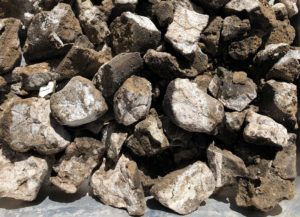Most soils form in sedimentary deposits left after events such as dust storms, landslides, floods, slope creep, glacier deposits and the like. When all the erosion and associated deposition stops, and things calm down – only then can other soil forming process begin. Soil formation represents the quiet-time in the geological record, following events like volcanic eruptions, landslides and floods. It is not uncommon for a single soil profile to contain a record of several geological events (floods, landslides and slope creep). Shown below is such a soil — the upper ~0.5 m part is windblown sand (aeolian), the next ~0.3 m is reactive dark brown clays derived by soil creep from the dolerite on one side of the valley. The lower lighter part is derived from a massive landslide (debris flow) deposit from up valley.

So soils are a record of environmental changes in landscape stability. They are beautiful.
Here is another example – here two different types of flood deposit – one a gravelly and stony former river channel deposit (lower part) is capped by finer silts, sands and clay from flooding over the river plain (over-bank deposits) away from the channel. The ‘alluvial’ soil forms in these lovely fine flood plain deposits.

Once layers of geological materials such as sand from dust storms is stabilized then soil horizons start to develop – the simplest example is the topsoil – things die and fall on to the ground – topsoils are a record of all the death in the environment, it is recorded as soil organic carbon in the soil layers. This dead material is food for soil living organisms like bacteria, fungi and earthworms and the like – they help mix the topsoil and smear the dead organic matter around forming humus.
Other soil horizons can form by water moving down through the soil and redistributing the chemical, mineral and organic components over time. Soil salinity is a great example of this – salts wash down through the soil and collect in deeper layers or the groundwater — they can often move from there to the lower parts of a slope and cause salt seeps and scalds. Soil lime (or carbonate) is another example where soil materials containing calcium are rinsed out by CO2 enriched drainage water (leached) and calcium-carbonate (lime) builds up deeper in the soil. Below is a terrific example of this under an Aboriginal Midden on Midden Road at Carlton Beach. The shells left by humans over several thousand years at the soil surface are dissolved (leached) and redeposited as a carbonate rich layer deeper in the soil (below 1.1 m) – see the photos below of drill core and close-up, note the calcium carbonate coating the clay and stabilizing the soil structure.


Other examples of materials leaching down through soils include soil organic matter dissolving in acidic, sandy, quartz-rich soils and being redepositing down in the subsoils as a dark layer. We call these special soils ‘Podzols’ which is a Russian word meaning ‘ash underneath’, this refers to the light ashy colour zone of the soil which is all leached and bleached or nutrient and carbon. Below this is the redeposited carbon rich layer – it looks like a chocolate and is sometimes called ‘coffee rock’ as the organic matter cements the sand making a hard layer.

We hope you liked learning about the geological layers which make up the basic skeleton of the soil profile and then the soil processes which may add extra details; both complexity and beauty – this combination provides what we call soil horizons, i.e., geology and soil process joined together.
